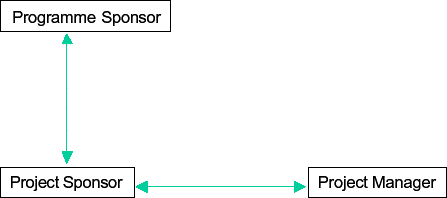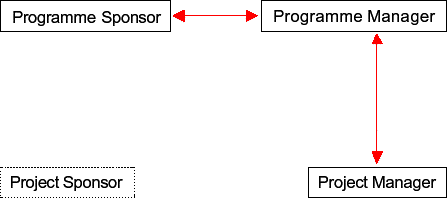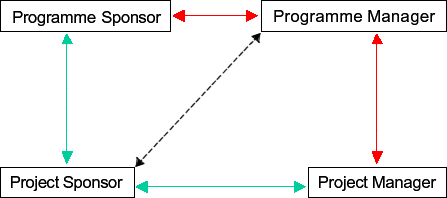The Program Management Framework
Program management starts with the "Vision Statement", what Sir John
Harvey Jones (previously CEO of ICI) describes as "a dream on the edge of
reality". This is the leadership team's (or leader's) view of where the
organization is going. A vision statement should therefore describe to the organization's
internal and external customers the definition of what to expect from the organization
in the future. As the MSP puts it, the organization's service levels "after
its transformation". The vision statement is a statement to the stakeholders
of the end-goal of all the organizations programs.
The MSP includes a document referred to as "The Blueprint". This
sets out the structure and composition of the changed organization that, after
delivery, should demonstrate the capabilities expressed in the vision statement.
The blueprint is a detailed description of what the organization looks like in
terms of its business processes, people, information systems and facilities,
and its data. It is used to maintain the focus of the program on the delivery
of the new capability.
One of the differences between myself and MSP is that the inference of MSP
is that there is one program only. However, I believe there can be a number of
programs coexisting in parallel, but not too many, perhaps somewhere between
5 and 20 as an absolute maximum. Each program should be the responsibility of
a key executive or board member. These programs collectively make up the strategic
plan designed to deliver the vision for the organization.
For me, the difficulty with the blueprint is that at the outset of the program
it may be very hazy, especially for certain kinds of program such as R&D
as described earlier by Sergio Pellegrinelli and Martin Davies. Nonetheless,
trying to define the future by means of a blueprint is still a worthwhile endeavor.
It is one of those rare things where thinking through the process may be even
more important than the outcome!
A management organization structure with clearly defined key roles and responsibilities
is just as important for programs as it is for projects. In the early days of
program management, there were two ways of looking at the program structure and
its roles. Figure 8a below introduces the Program Sponsor
and the Project Sponsor.

Figure 8a. Introducing the program sponsor to project management
Figure 8b raises the possibility of individual project
sponsors, or the program manager becoming the sponsor for each project in the
program.

Figure 8b. Introducing the program manager to program management
Figure 8c consolidates the choices.

Figure 8c. Choices in program management roles and structure
Originally in project management the project manager was accountable for delivering
the project deliverables, or assets, to agreed time, cost and quality. The question
of who was accountable for delivering the benefits was unclear between the project
manager and the project sponsor.
When we overlay the prime roles of programs over projects, it can be seen that
we could retain the project sponsor and manager route, with all the project sponsors
reporting to the program sponsor, shown by the green arrows in Figure
8a. Or we might introduce a program manager, to whom all the project managers
on the program report, as shown by the red arrows in Figure
8b. In effect, this person becomes the sponsor for each project in the program.
Finally, we could retain all four roles and ensure a link between the program
manager and the project sponsors as shown dotted in black in Figure
8c.
I do not believe that there is a right answer. Only that a structure together
with the roles must be defined for each program. It is clear that the program
sponsor is usually a senior member of the client organization, typically operating
as an executive board member. This is one of the reasons why an organization
can only handle a certain number of programs at any one time. The program sponsor
is ultimately responsible and accountable for the program, the investment in
it, and the delivery of the corporate goals and benefits. The MSP guide refers
to the role of the program sponsor as "Program Director".
The Program Manager's role is responsible for setting up and running the program
and coordinating the projects within the program. This is to ensure that the
required projects' outputs are delivered efficiently and effectively.
|



